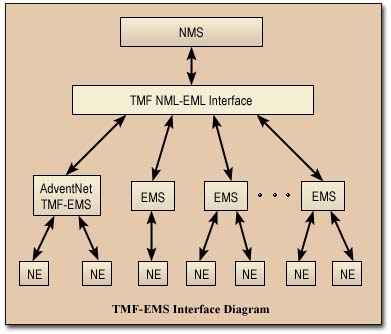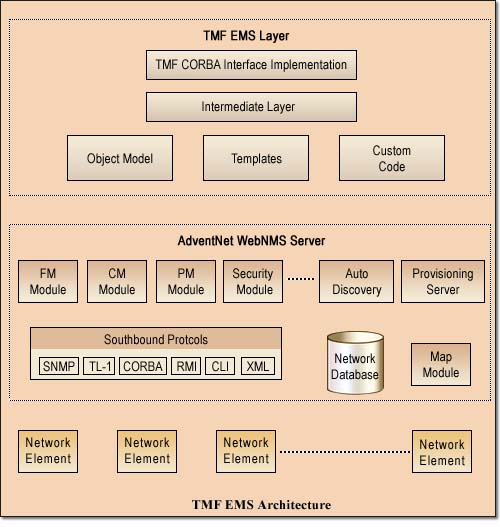AdventNet TMF EMS
Introduction
With the rapid advances in telecommunications technologies of the
recent past, the number of vendors supplying equipment to carriers
has increased. More than ever, service providers need integrated
end to end management across devices and technologies from many
vendors. They want to manage the multi vendor/multi technology devices
through a common management system that integrates across these
diverse set of devices.
The Tele-Management Forum (TMF) standards for multi-technology,
multi-vendor network management (TMF MTNM or TMF 513) provide new
opportunities for the integrated end-to-end management and provisioning
of multi-vendor networks. The TMF Standard facilitates this
by enabling a NMS to create and manage end to end connections and
devices across TMF complaint EMSs.
In order to enable such integrated management, telecommunications
equipment providers need to support TMF interfaces in their EMS
products. To help equipment vendors more easily deliver
TMF interfaces, AdventNet provides support for the TMF interfaces
as part of it's EMS framework. This document describes the
AdventNet's support for the TMF EMS interface.
Overview
AdventNet Web NMS is an extensible and scalable element management
System (EMS) framework with support for SNMP,CORBA, TL1 and many
other kinds of managed network elements(NEs). The AdventNet TMF
EMS is built on the Web NMS framework, and conforms to the NML-EML
interface and implements TMF513/608/814 version 2.5. The TMF
EMS will support rapid development of applications in all
core management services specified in the TMF standard, including
inventory management, provisioning, connection management, fault
management and equipment management for SONET/SDH, DWDM and ATM
networks. The applications developed based on TMF EMS will
be customizable to specific kinds of devices, and can easily be
extended to new devices and technology.
The AdventNet TMF EMS is designed to flexibly and rapidly enable
TMF support for new and existing EMS systems. Equipment vendors
can quickly provide necessary TMF interface support to fit into
integrated management solutions sought by carriers. This allows
carriers to more easily integrate a vendors equipment and EMS systems
into their network.

MTNM
MTNM is multi-technology network management. The TeleManagementForum
(TMF), formerly the NMF, is a global standards organization
that develops many management and OSS standards for the telecom
industry. The TMF MTNM (also known as TMF 513) is a TMF standard
for integrated management of telecom networks. It is a standard
for multi-technology, multi-vendor network management that provides
new opportunities for simplifying the end-to-end management and
provisioning of multi-vendor networks. It is becoming mandatory
for providers of telecommunications equipment to offer a TMF MTNM
complaint EMS application to support each of their network elements,
making it easier to integrate these network elements into carrier
networks. Release 2.5 of this specification is described by
the TMF documents listed below.
- TMF.513, Business Agreement (BA),
- TMF.608, Information Agreement (IA),
- TMF.814, Interface Definition Language (IDL) Solution Set, and
- TMF.814A, Implementation Agreement.
For more details on TeleManagementForum(TMF) please refer to www.tmforum.org
AdventNet recognizes TMF MTNM as a useful standard for Multi-Technology
Multi-vendor Management. With our new support for TMF MTNM,
AdventNet customers delivering EMS systems will more easily be able
to support TMF MTNM and associated standards. AdventNet's
focus on helping our customers has helped us deliver measurable
business value to them in terms of productivity and time-to-market
gains. This new support for the TMF MTNM EML interface will
increase the value of our customers equipment and EMS solutions
in the marketplace.
Architecture
The TMF-EMS architecture is based on the AdventNet WebNMS architecture.
The TMF EMS has been split into two functional Layers.

TMF Corba Interface Implementation
This layer has the implementation of all the Interfaces specified
in the TMF 814. All mandatory methods of managers specified in the
TMF have been implemented. This layer communicates with the intermediate
Layer for any database related activities.This interface responds
to the requests from NMSs and other OSSs through the NML-EML interface.This
Corba Layer is independent of the underlying data model and acts
as a wrapper to the intermediate Layer
Intermediate Layer
This layer communicates with the database and network elements.
A default implementation has been provided with TMF EMS, if TMF
object model is used. The intermediate layer can be customized by
a developer to support an existing vendor specific object model
if required, instead of using the default TMF model supplied by
AdventNet.
Key Features
- Support for both TMF Object Model and Vendor Specific Object
Model.
- Loose coupling between modules.
- Support for both TMF specific events and Vendor Specific events.
- Customizable provisioning.
- Support for connection management.
- Database operations performed default in provisioning.
- Highly Customizable.
- Implementation of Fault, Topo, Notification, Configuration
and Provisioning management as per the TMF specifications.
- Fail Over/High Availability support and Load Balancing.
- Custom Views for data.
- Support for Application,Applet and HTML UI.
- Support for building integrated vendor specific user Interface.
Target Market
AdventNet TMF EMS is targeted at two types of EMS Software Providers
- Equipment Vendors - AdventNet
TMF EMS supports development of EMSs for NEs and also provide
North-bound Support at the NML.
- Independent Software Vendors(ISVs)
- AdventNet TMF EMS supports development
of turnkey EMS applications by Independent Software Vendors.
Compliance
AdventNet TMF EMS is compliant to ATM/SONET/SDH/DWDM Fault and
Configuration Management solution as specified in TMF 814A version
2.5 document. The AdventNet TMF EMS is built over the AdventNet
Web NMS platform. This leverages TMF EMS to go for complex solutions
which needs high availability and high scalability. Also this ensures
that all the basic functionalities of AdventNet Web NMS can be available
in TMF EMS also.
Standards Compatibility
The following presents an overview of the standard technologies
on which the AdventNet TMF EMS is built.
| S.No |
Standard/Technology |
Version Supported |
Key Benefits |
| 1. |
TMF |
2.5 |
TMF provides opportunities for the end-to-end management
and provisioning of multi-vendor networks. |
| 2. |
XML |
1.0 |
XML facilitates an efficient data interchange between components
of an application and between applications by providing an
extensible mechanism to describe the meaning and hierarchical
structure of data. |
| 3. |
JAXP |
1.1 |
JAXP provides a standard API to process XML documents using
DOM, SAX and XSLT. This makes it easier for applications to
choose a XML parser implementation based on application need
i.e. high performance parsers Vs. low memory foot print parsers
etc. |
| 4. |
JDBC |
1.1 & 2.0 |
JDBC provides database vendor and technology independent
(RDBMS, ODBMS etc.) and platform neutral API's to access data
from multi-tier and client-server applications. |
| 5. |
HTTP |
1.0 & 1.1 |
HTTP facilitates a standard communication mechanism between
Web Browser Client and the Web Server. HTTP is also used as
communication mechanism between other client and servers. |
| 6. |
JFC |
JDK 1.2 & JDK 1.3 |
Java Foundation Classes (JFC) is a collection of widgets,
facilitates building user interfaces (GUI's) that have a platform
independent visual presentation. |
| 7. |
JSP |
1.1 |
Facilitates having dynamic content in Web pages by allowing
you to embed Java code in HTML pages (You can have your presentation
and dynamic content separated by using Java Beans and JSP
tags. |
| 8. |
CORBA |
2.3 |
CORBA provides a programming language independent distributed
object computing environment on which highly scalable applications
can be built. |
| 9. |
SNMP |
v1,v2c & v3
|
The Simple Network Management Protocol (SNMP) is the most
widely used management protocol, that defines the communication
mechanism between the managed entities and the management
station, the information model and the security and access
control mechanisms for sharing management information. |
| 10. |
TL1 |
1.0 |
Transaction Language 1 (TL1) is an ASCII based management
protocol widely used in the telecom industry for managing
the telecom infrastructure. Since TL1 is ASCII based, it can
be used as both Human to Machine & Machine to Machine
language, without any translations. |
Evaluation copies of AdventNet TMF EMS are
available. Please contact AdventNet sales
for an evaluation copy or for a demonstration of the product. For
technical support, please contact AdventNet technical support via
email at nms-support@adventnet.com.
|


